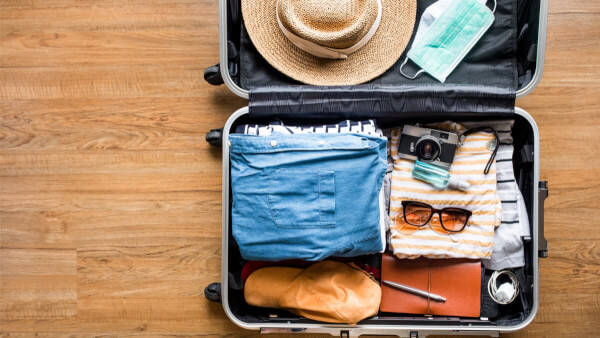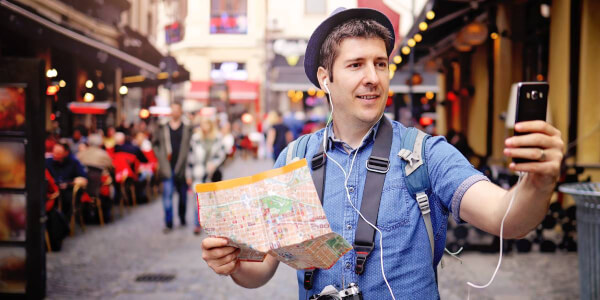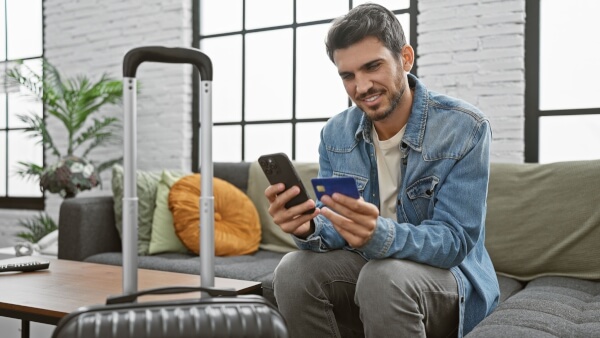UBank vs Wise card - Which is the better travel card to use overseas in Australia?
Looking for a travel card to use overseas? We compared the fees, features, and benefits of two top travel cards: Ubank vs Wise, for Australian travellers.

Travelling abroad can still require hard cash, especially for tips, markets, local spots and ‘just in case’ moments. Credit and debit cards, and mobile wallets, are increasingly popular and accepted everywhere, but having local currency can make travel easier.
What are the best ways to get foreign currency before or while travelling? Read on to learn more about getting foreign cash from banks, money exchanges or ATMs, plus how Wise travel card as a convenient way to manage your money internationally.
If you need to send money abroad before you travel, consider an international transfer. Check out the cheapest ways to make a transfer and save on fees.
| Table of contents |
|---|
In the past, travellers had to convert all their trip money into foreign currencies when heading abroad. Often, the money would be converted beforehand by banks for a fee, or once arrived at the destination, since cash would be the only way to pay for hotels, tours and meals.
Nowadays, while credit and debit cards have made international payments easier, cash can be helpful. But converting Australian dollars into a foreign currency still comes at a cost and different factors can influence how much you pay. Let's break down typical costs with a currency conversion.
If you’re converting to another currency, banks, credit card companies or foreign exchange shops may charge you the following: transaction fees, hidden exchange rate fees and exchange rate markups.
Banks and financial institutions may charge a service fee for every foreign currency conversion, also known as a transaction fee. The amount can vary depending on the institution and can even be relevant when using a debit card. It is the charge for providing the service.
If you’re dealing with cash, a transaction fee may come under the name of an ATM or bank fee when you receive the converted cash.
Keep in mind that if a company advertises that they don’t have a transaction fee, it doesn’t mean it will be the cheapest option. There is a chance they may be making up for it in the exchange rate markup. Let’s take a look at that next.
Each currency has a unique exchange rate with another one, which can fluctuate everyday or minute depending on market forces, the country's economy and government policies.
The exchange rate you usually see on Google is the mid-market exchange rate. However, when consumers exchange or convert funds, many providers often use a rate that is different. This markup in the currency conversion rate can quickly add up to the cost of exchanging currencies. We recomment compare exchange rates of any provider to the mid-market rate to see if you're getting a hidden fee.
Another fee to be mindful of is the forex markup fee charged by some providers, Sometimes it may be in addition to a more expensive exchange rate set by the bank or company, or you may get the mid-market exchange rate but with a markup on top.1
You got your tickets and now it's time to prepare for your upcoming trip. One important part is to figure out how to pay for expenses. Review your itinerary and see if any accommodations, restaurants or tours require cash payments, then set aside a budget for additional expenses that may need cash.
Once you have an idea of how much you may need in cash, you can decide if you want to convert your Australian dollars into local currency before you leave. The benefit is that you’ll have the money when you arrive; the downside is that you may pay more for it than if you did so locally. If you are considering getting foreign currency from your home country, here are some ways to do it:
You can buy foreign currencies at banks and financial institutions. The process is typically simple, but keep in mind that you may be hit with fees.
If you don’t use all your cash, sometimes your bank may buy back your unused foreign currency. Just be ready because you may have to pay fees and lose money to the exchange rate on the conversion back to Australian dollars.
Money exchange providers are typically stand-alone shops that offer foreign currencies for purchase. They often have their exchange rates listed and you can go in and buy the amount you need. Money exchange providers have the currencies listed on hand, but you may be able to request a specific currency if they don’t have it.
While money exchange providers can be simple, they often can be expensive. On top of setting their own exchange rate, which can include a markup, they often have transaction fees as well. Plus, you will be required to go physically to the store.
The Australia Post is another option for ordering cash beforehand online or at your nearest branch. They offer over 40 different currencies with a maximum limit of $5,000 AUD.2
Mixing money and loved ones can be tricky but friends and family can be helpful for currency conversions if they have the exact one you need. For instance, they may have leftover cash from a previous trip abroad. In this situation, you can transfer the amount in Australian dollars to their bank account or provide cash to pay for the foreign currency. However, some points to keep in mind are:
As a traveller, it can get confusing when figuring out exchange rates, fees and where to get cash. Friends and family are helpful but you’ll need consensus on the rate. Banks and money exchange providers offer convenience, but you might not get the best exchange rates.
The first place to start is Google or Reuters to see what the mid-market exchange rate is. From there, you can compare different providers to look at where to get the best deal. Check out Wise’s Currency Converter to see today’s mid-market exchange rate and for the option to track it.
Depending on where you’re going, getting cash when you arrive can be an easy and low cost option. It doesn’t require you to bring cash from home and you can take advantage of ATMs, banks or money exchange providers locally. Of all the options, an ATM is going to be the most convenient one, but make sure you can use your cards abroad, you have the right ATM network and be aware of fees. More on this later.
Some countries may lack the infrastructure to access cash upon arrival, which can make just getting a taxi from the airport difficult. If your destination is off the beaten path, do your research on the country and see if it is recommended to bring cash with you or to get it there.
Banks and money exchange providers can offer you currency conversions when you arrive. Banks are typically trusted and can have multiple branches in major cities, but have certain limitations. For example, banks are not available 24/7 and surprise bank holidays will make it hard to get cash over the counter when you need to. So instead of exchanging Australian dollars in cash in your destination country, the best bet is to use an ATM.
Money exchange providers are another option. They operate independently from banks but fulfil a similar service when getting local currencies. You can make payments in cash or with an international card and they will provide the local currency. They will likely ask for documentation to verify your identity before exchanging the funds.
While money exchange providers can be widely available, they also tend to be very expensive. Exchange rates typically have a markup and you’ll likely pay transaction fees too. If you are in an emergency or crisis using one can make sense, but otherwise, you may want to avoid them and use a bank ATM instead.3
As soon as you land, you’re likely to find airport kiosks offering money exchanges. It can look like an easy and simple way to convert cash, but they usually have expensive exchange rates. This could be true even when they advertise “no fees”. Watch our video on the 3 solid reasons to avoid airport money exchanges 👉.
If you are looking for convenience, consider a bank ATM within the airport instead of the airport kiosks. Or better yet, the Wise Travel card lets you tap, swipe and spend in multiple countries' local currencies.4
Still not sure what to do? Check out our video on whether you should buy foreign cash before travelling 👉.
Can you withdraw local currencies from ATMs abroad? In most cases, the short answer is yes. It can be a super convenient way to get cash while travelling without the hassle of bringing over the funds. However, you have to keep in mind the following to ensure you get cash and don’t overpay in fees:
As an alternative, we would like to introduce you to the Wise Travel Card that offers free ATM withdrawals for up to 350 AUD per month in 2 or less withdrawals, and low convenient pricing for withdrawals above. Plus, with Wise you always get the mid-market exchange rate on currency conversion. You can use the Wise Travel Card in countries and swipe like a local to make purchases at restaurants, stores and local sites.
Note that ATM providers might charge their own additional fee per withdrawal. Please see terms of use and product availability for your region or visit Wise fees and pricing for the most up to date pricing and fee information.
Wise offers a convenient travel card and money transfer services that make managing your finances abroad a breeze. The Wise card lets you spend like a local in over countries, with
Please see terms of use and product availability for your region or visit Wise fees and pricing for the most up to date pricing and fee information.
*Please see terms of use and product availability for your region or visit Wise fees and pricing for the most up to date pricing and fee information.
This publication is provided for general information purposes and does not constitute legal, tax or other professional advice from Wise Payments Limited or its subsidiaries and its affiliates, and it is not intended as a substitute for obtaining advice from a financial advisor or any other professional.
We make no representations, warranties or guarantees, whether expressed or implied, that the content in the publication is accurate, complete or up to date.

Looking for a travel card to use overseas? We compared the fees, features, and benefits of two top travel cards: Ubank vs Wise, for Australian travellers.

Planning to use your UBank card to make ATM withdrawals internationally? Read on to understand the true cost of overseas transactions with UBank.

Wondering if Travel Money Oz is the right solution for you? Our guide outlines everything you need to know about their currency exchange and travel money cards.

If you're trying to decide between Travelex and Travel Money Oz for your international money needs, read on for our side-by-side comparison of the features.

Side-by-side Comparison of Westpac Travel Card vs Wise Travel to help Australian users decided which is a better travel card for spending abroad.

Looking for a card for international transactions while traveling overseas? Read on for our guide to the options available with Macquarie Bank.